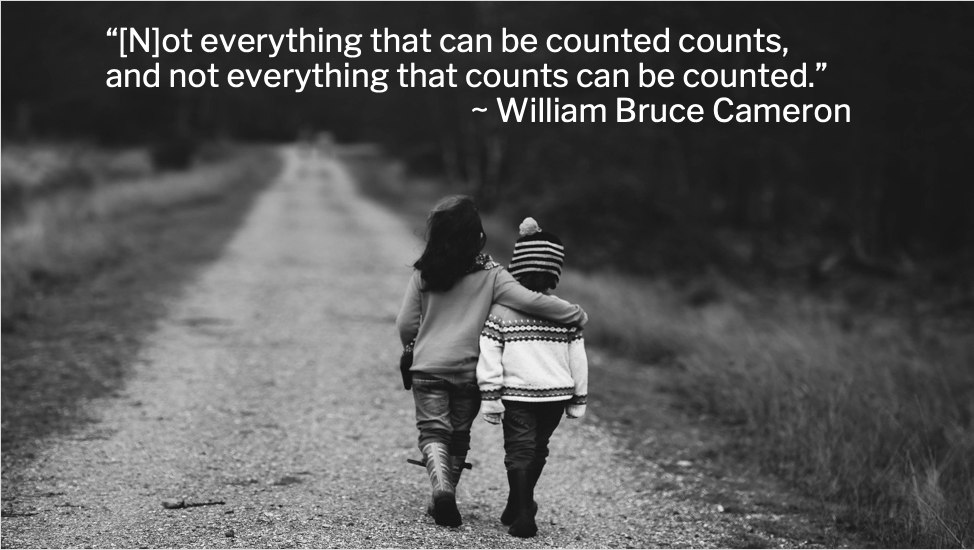 How to Motivate Volunteers & Get Buy-In for Outcomes Management
How to Motivate Volunteers & Get Buy-In for Outcomes Management
When we think about how to motivate volunteers, we often first think of volunteer recognition activities. How can we reward volunteers for their dedicated service? What should we include in this year’s recognition luncheon? How can we get our co-workers to show their appreciation more often? Should we continue to offer the five-year pins?
Rarely do we associate volunteer motivations with performance management. But, perhaps that’s an oversight?
Often when you ask volunteers directly what energizes them, you’ll hear the familiar refrain “I came to make a difference.” It truly is that simple.
Volunteers want to make an impact. So, what could be more compelling than to share how much of a difference has been made than with performance metrics?
But service numbers and outcomes indicators don’t really prick up the ears of many volunteers, do they?
I remember enthusiastically sharing the outcomes of our work with volunteers and hearing back, “you just care about the numbers!” Nothing like extreme blowback to dampen your day.
Linking Volunteer Motivation and Performance
Years ago, I was working with a client and we revisited the topic of motivation. We wondered if it were possible to develop a performance management system that BOTH promotes outcomes AND inspires people.
Do these two goals sound mutually exclusive? I may have thought so in the past, but not anymore.
If you’ve ever experienced the “joy” of introducing new performance metrics to your team or network, you know how tough it can be. Then, when you ask people to be accountable for the outcomes? Not so easy.
Push back is pretty normal, as I noted above. So how can you move past the negativity and toward team success and maybe even excellence?
Here’s the deal. Research shows that people are not motivated by punitive measures.
So, first off, retire the old “carrot and stick” analogy. It just won’t work.
Nagging isn’t a viable management strategy.
Instead, consider tapping into what research shows really inspires.
People are motivated by:
1) Their Peers —We humans have a strong herding instinct. If everyone else is doing it, we feel we should, too. It’s kinda scary, but true nonetheless.
2) The Possible —Studies have shown that people will throw their support behind a cause they feel is win-able in the short-term, versus a cause that may have much more impact in the long run.
3) People —Individuals, that is. We care more about the plight of one than the plight of many, and we’ll make our decisions based on an emotional connection to that one person (even if we don’t know them personally).
4) Participation —If social media has taught us anything, it’s taught us that we will actively engage when allowed authentic shared participation.
So, what does this have to do with performance management? Tapping into these realities, below are some specific ideas and tactics you can use to galvanize both staff and volunteers alike.
 How to Motivate Volunteers: Practical Steps
How to Motivate Volunteers: Practical Steps
I noted four things in the section above that motivate people — their peers, the possible, people (individuals), and participation.
Now, let’s consider specific steps you can take to tap into these key drivers while at the same time promoting performance outcomes. Let’s draw some connections between theory and practice.
Consider these practical approaches that support program performance, based on what the research tells us about human behavior:
Motivate via Peers
Encourage a bit of healthy competition. Create graphics that compare key performance metrics between teams or individuals. To be sensitive, leave out all team or individual identifying information, highlight the outcome for each team, and how they compare to others across the spectrum separately. Or, use a progress thermometer to track the global progress for one key outcome.
Inspire the Possible
Focus on an incremental change that promotes success early and often. Break annual targets into doable chunks and focus efforts on a few outcomes versus all of them. Celebrate improvement, even if there’s still a long way to go. Early success will help create a snowball effect.
Use People’s Stories to Win Hearts and Minds
Recognize and reward individual contributions to progress. Share their stories via videos and agency newsletters and incorporate storytelling into recognition events. Be sure stories have a clearly described plotline, details on the challenge, and what was done to bring about change.
Spark Participation
Get people at all levels of the organization involved early in the development of a performance system. Create open forums where people can discuss their experiences and give each other tips. Also, reward success with increased participation. For example, recognize individuals for their hard work by inviting them to act in an advisory role in program development.
In these ways, you can help volunteers to see the connections between their work and community impact. You can also generate momentum as volunteers and employees begin to get traction. And, if they’re stuck, they have a forum and a common vocabulary to discuss possible barriers and remedies to success.
 Best Practices: A Powerful Tool
Best Practices: A Powerful Tool
Finally, and most important, create a formal system to collect and share proven best practices. This an often overlooked, but very powerful, way to boost performance.
Best practices take into account each of the four motivators listed above. Peers share with each other their bright spots, the possible is highlighted through tactics that have been proven to work, every best practice involves people and their stories of triumph, and everyone can participate by sharing their particular expertise. It’s a win for everyone.
When collecting best practices, make it easy for teams to share. The best way to do this is to create a template that everyone can use to share their field notes. You can host it in a Google form to make data collection free and easy for everyone.
Providing a framework also helps teams determine whether what they’re reporting is a “best” or “promising” practice. If teams have tried something once and it’s working, it’s not necessarily a best practice yet.
So, help them by including a framework in your form. Here are the four criteria we often use:
- Is it creative or new?
- Does it truly make a difference (can you show the results)?
- Is it sustainable over the long term?
- Can it be replicated by other teams?
If they have great ideas that appear to be able to solve a problem, that’s not a best practice either. While good ideas may become a best practice, they are not considered one until they have demonstrated results.
Best practices should be: innovative, sustainable, replicable and, above all, proven.
Once you’ve documented a set of best practices, you can share them with others inside your organization to disseminate learning and foster improvement. You can also share them outside your organization to educate others.
Either way, you’re acknowledging the work of volunteers and encouraging them to explore new avenues for making a difference and generating more buy-in for performance management along the way.
How Do You Get Buy-In for Outcomes?
What do you think? Have you tried any of these tactics? Did they work? Do you have others to suggest?





